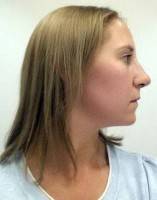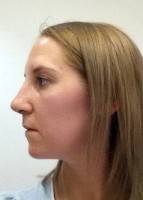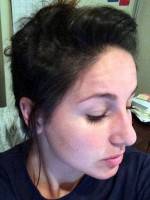Nose job without breaking bone
Nose job: Types of Fractures or bone cuts
The use and type of fractures in nose job depend on the goals to be achieved. Sometimes no fractures (we call them osteotomy = bone cuts).
Occasionally we use one fracture on one side of the and different type of the other side. They are used to push bones in or to push them out.
Sometimes the bones are completely cut and shifted and other times they are perforated like a sheet of paper and partially attached (greenstick fracture) (Otto Joseph Placik, MD, Chicago Plastic Surgeon)
Nasal Bone Management During Nose job
Although the nasal bones may be “cut” (osteotomized) and repositioned during nose job, I don’t think any of us would use the term “snap” or “break” to describe what is really a meticulous maneuver to create the most aesthetically pleasing nose possible.
Keep in mind that not every nose requires modification of the nasal bones. Typically, those that are wide, crooked, have post-traumatic deformities, or require modification for airway improvement may require osteotomies.
So, if this is your greatest fear, fear not. This component of nose job has been performed countless times by innumerable surgeons over the past century. As long as your surgeon is board certified and specializes in nose job surgery you should have nothing to worry about. As for “urban legends”, many are based on reality and the reality is often much less dramatic than the legend. (Jeffrey Weinzweig, MD, Chicago Plastic Surgeon)
Your surgeon will never “break” your nose during nose job
The nasal bones are precisely and delicately “cut” during nose job for one of two reasons. The first, your nose is deviated (crooked) and your bones must be cut and re-set in the middle.
The second, you had a bump that was removed leaving an opening in the “roof” of the nose and the bones are cut to close that roof. These is a very precise and controlled procedure and should not be confused with “breaking the nose.” (Stephen Weber, MD, FACS, Denver Facial Plastic Surgeon)
Your nose may get broken during nose job
Your nasal bones may or may not be broken during a nose job Fracturing the nasal bones is necessary, if they are crooked to start with, or if a large hump is taken down. Relax however.
This is very different from you breaking your nose in a sports injury for example. First of all you will be completely anesthetized so you don’t feel anything. Secondly, this is a controlled break rather than a whack on the face.
You really should not worry about this feature of a nose job. It sounds scary, but it isn’t any more scary than the rest of the procedure. (Raghu Athre, MD, Houston Facial Plastic Surgeon)
Breaking the nose during nose job: It’s more finesse!
As seen from the front, the nose should not look like a sausage, it should widen at the top and bottom and taper in the middle (like an hourglass). In order to achieve that type of harmony between the upper and lower parts of the nose, your surgeon may need to manipulate the nasal bones.
Through small incisions, precision cuts are made in the bones in order to free them and allow the nasal bridge to be narrowed or widened. Remember, the nasal bones are not “broken” haphazardly!
They are precisely cut in order to maintain symmetry. This is useful for patients whose nasal bridges are not straight and after a large hump is removed to restore a nice rounded contour to the nasal bridge. Patients need to wear a cast for about 5 -7 days for protection.
The edges of the bone cuts fuse together in a few weeks. When done properly, the edges of the cuts are not visible. Visit with your facial plastic surgeon for a full evaluation. (Anand D. Patel, MD, Brookfield Facial Plastic Surgeon)
Breaking the nose during nose job
The nose job procedure involves reshaping the nasal skeleton, which is made of cartilage and bone. After the hump is brought down (which is both cartilage and bone), the sides of the nose must be narrowed. This is done by performin osteotomies, which are basically cuts on the bone. This is necessary to give the nose a balanced and proportioned look. You should not be afraid of this, as this does not cause any pain durring or after the procedure. (Andres Bustillo, MD, FACS, San Diego Plastic Surgeon)
- Nose job without breaking bone picture
- Nose job without breaking bone photos
- Nose job without breaking bone images
Rhinoplasty involves multiple steps and not all the same for each individual patient. If a bump on the top of the nose needs to be taken down, then the nasal bones often have to be infractured, or carefully cut so that the bones can slide in and leave the desired nasal appearance both by narrowing the nose and correcting the “lines” of the front appearance. (Steven Wallach, MD, Manhattan Plastic Surgeon)
Nasal Infracture Varies From Patient to Patient
Rhinoplasty surgery varies from patient to patient and depends on a variety of factors. Not every patient requires nasal infracture (breaking the nose), but for some patients it’s absolutely essential and without infracture it would be impossible to obtain a good result. Patients undergoing rhinoplasty require a comprehensive evaluation. This requires physical examination and review of pictures from multiple angles. In your case, it’s difficult to make a treatment recommendation without this information. As a general rule it’s usually necessary to perform an infracture when large humps are present or when the nasal bridge is wide. When isolated nasal tip abnormalities are present surgical infracture can usually be avoided.
It’s not unusual for patients to be afraid of having their nose broken during surgery. Unfortunately for many patients meeting their aesthetic goals requires infracture. When infracture is performed there may be slightly more swelling and bruising. Patients usually have minimal pain and discomfort following this maneuver. If you’re considering rhinoplasty, consultation with a board certified plastic surgeon is appropriate. This surgeon should be able to help you formulate an appropriate treatment plan. (Richard J. Bruneteau, MD, Omaha Plastic Surgeon)
Rhinoplasty and What is Involved
The purpose of a preoperative consultation is to make sure that your and your Surgeon are on the same page as far as your goals. Assuming your goals are realistic, a good Rhinoplasty Surgeon will be able to employ a range of techniques to achieve a result you will both be pleased with.
Breaking the nasal bones, or osteotomies, are sometimes necessary in order to accomplish the aesthetic result desired; in fact, failure to perform osteotomies is sometimes a mistake.
The purpose of being a well educated patient is so that you can weigh the benefits and risks of the procedure and make a good decision. Likewise, this information will help you understand that your Surgeon can’t accomplish your goals if he/she is limited in the techniques that he/she can employ. (Stephen Prendiville, MD, Fort Myers Facial Plastic Surgeon)
Will my Doctor Break my Nose During a Rhinoplasty
The osteotomy (breaking of the bones) may not occur with your surgery. This is used when a large hump has been taken down leaving a large flat surface.
When an osteotomy is done it is done with very fine movements and delicate cuts to improve the shape of your nose. (Paul Vitenas, Jr., MD, Houston Plastic Surgeon)
Breaking the Nasal Bones
Depending on the scope of the surgery, it may be necessary to break the nasal bones. While the thought is unnerving for some, the actual process is precise and the pain involved is mild. (Kris M. Reddy, MD, FACS, West Palm Beach Plastic Surgeon)
Does the nose have to be broken during rhinoplasty?
Breaking the nasal bones, or controlled infracturing, during rhinoplasty is a delicate and refined technique to narrow the bridge of the nose.
If a large hump is taken down, the bridge may look like the top of an aircraft carrier. The nasal bones then need to be brought in to round off the edges. This creates a more refined and natural appearance. (Etai Funk, MD, Houston Facial Plastic Surgeon)
Rebreaking the nose in a controlled fashion may be necessary.
Doctors do oftentimes during rhinoplasty break the nose in a very controlled fashion. While this takes a great deal of skill to do it appropriately and in a constructed manner you shouldn’t be fearful of having this done. Re-breaking the nose can allow the surgeon to straighten the nose as well as to make it smaller. In addition, with the controlled techniques that we use today, patients typically do not have a lot of discomfort after having rhinoplasty which includes breaking the nose or osteotomies.
Discussing your concerns with your surgeon beforehand should make you comfortable with osteotomy if it is a necessary being a part of your rhinoplasty. (Mark Hamilton, MD, Indianapolis Facial Plastic Surgeon)
Breaking the Nose In Rhinoplasty
It is considered an urban legend that whenever a patient has a rhinoplasty that the nose is “broken”. However, that is not necessarily true. It depends on whether this needs to be performed to improve nasal appearance or to correct nasal deviation.
In my practice, about half of the time the nasal bones are not fractured or broken as part of a rhinoplasty. It depends on the analysis of the patient’s problem and what is needed to optimize the result for cosmetic improvement on the nose. (Rod J. Rohrich, MD, Dallas Plastic Surgeon)
Nasal Fracture? How Do You Know if Your Nose is Broken?
If you had trauma to your nose and have new difficulty breathing, it is important to be examined to make sure that you do not have a nasal septal hematoma (which could destroy your nasal cartilage, resulting in a “saddle nose” deformity).
If your nose is off to one side of your face like a Picasso, and not swollen yet, it can be reset, but don’t wait too long because swelling is on its way.
Once the nose is swollen, you should wait 5 days and then be evaluated by a rhinoplasty specialist, or ENT physician.
If the bones are crooked and displaced, then a closed nasal reduction of the fracture is indicated. If the bones are straight, then as they say in New Jersey, “Don’t think ’bout it”.
Unless there are legal or insurance concerns, nasal X-rays are usually a waste of time and money. How is “the other guy?” (Michael A. Persky, MD, Encino Facial Plastic Surgeon)
Nasal fractures
The best way to detect a nasal fracture is to wait until the swelling does down (usually about 7days). Keep your head elevated and use ice.
After 7 days, if you notice any functional (trouble breathing) or cosmetic changes to your nose, there is a high possibility of a nasal fracture. (Sandy Sule, MD, Dallas Facial Plastic Surgeon)
Diagnosing a broken nose can be difficult.
Many people will hit their nose hard enough to cause them concern over a possible fracture. Sports injuries, diving and conflicts can all lead to a broken nose. Two parts of the nose that are commonly broken are the paired nasal bones in the upper part between the eyes and lower part which is primarily septal cartilage.
Injuries to either or both can cause problems with breathing and change the outside appearance of the nose. How do you know if you have broken your nose? Usually an good bump will cause the nose to swell.
Once the swelling goes down in a week to 10 days, a crooked bridge or a new breathing problem is a good indication of a fracture of some sort. In severe injuries a fractured bone can be seen if the bridge is now crooked when it was not before.
Tenderness that lasts more than a week is another good sign that the bone is broken. I find that getting an x-ray is of low value for the patient. Bone breaks may show up, but many times slight breaks in the bone do not cause any change in appearance or a breathing problem and do not need treatment.
Obvious fractures of bone and cartilage are easily seen during an examination. I feel that that exposing the patient to an x-ray is unnecessary even though the radiation dose is low it is still more than zero.
Also, fractured cartilage will not show up on most x-rays and can only be seen during surgery.Bottom line, if your nose looks different or you have trouble breathing that is new-see a nose specialist. (Ivan Wayne, MD, Oklahoma City Facial Plastic Surgeon)
How do you know if you have a broken nose?
The short answer is that you wait for any swelling to resolve (usually 3-5 days) and then see what the nose looks like as compared to before the injury. If it still looks deviated or crooked, it might be a good idea to have it repaired at that time.
Often the initial swelling and bruising can make the nose look very distorted, but things settle back into looking like it did before the trauma after several days. This is why typically, I wait about 5 days before trying the surgically treat any nasal fracture. X-rays have limited value in evaluating and treating nasal fractures, because, ultimately, the decision to treat any nasal bone fracture is based on the cosmetic and functional state of the nose.
There are many times the x-rays show a nasal fracture, but the nose looks fine, and there have been many cases where the x-ray is negative, but there is clearly a deviation when seen in person. Trauma to nose can also result in breathing issues which can’t be diagnosed by x-rays. My advice is that if there is any doubt that you have a broken nose, go and have a specialist (e.g. a facial plastic surgeon) take a look at it. (Haresh Yalamanchili, MD, Houston Facial Plastic Surgeon)





